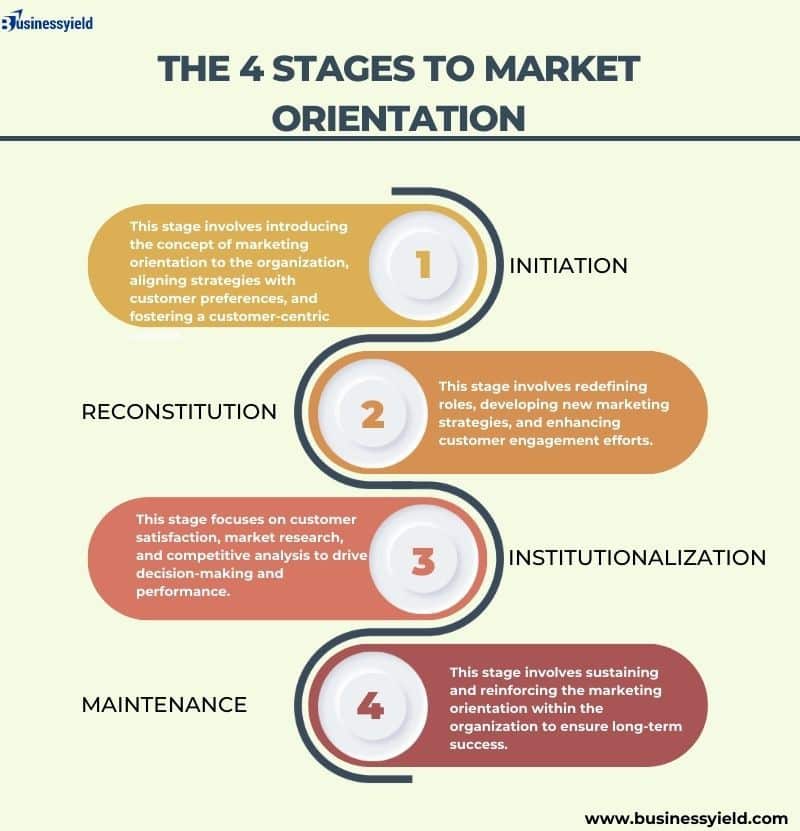Have you ever wondered what sets successful businesses apart from the rest? I know you have numerous answers but there’s only one thing I am sure is the correct answer. The key lies in understanding and implementing marketing orientation. In today’s competitive market, having a customer-focused approach is essential for sustainable growth and long-term success. So, keep reading as I share with you the fundamentals of marketing orientation, the types, and examples. I’ll also explore how businesses can truly thrive by putting the customer at the heart of their strategies.
Key Points
- Marketing orientation emphasizes the importance of focusing on customers’ needs and wants.
- Conducting thorough market research is essential to gather insights on customer preferences, trends, and competition, and also aligning all aspects of the business, such as product development, pricing, promotion, and distribution, with the needs of customers.
- It also involves creating a customer-centric culture within the organization and continuously adapting to changes in the market.
- Companies that successfully adopt marketing orientation are more likely to build strong customer relationships, increase customer loyalty, and achieve long-term business success.
What Is Marketing Orientation?
Marketing orientation is a business approach that focuses on understanding and meeting the needs and wants of customers. It is about putting the customer at the center of all business decisions and strategies. Customers are king. I believe that having a marketing orientation is crucial for businesses to thrive in today’s competitive landscape. By continuously studying consumer behavior, preferences, and trends, you can focus your company’s products, services, and marketing strategies to align with what customers are looking for in the market. This customer-centric approach not only leads to increased customer satisfaction but also fosters long-term relationships with clients, ultimately driving business growth and profitability.
Imagine you are launching a new product and want to ensure its success in the market. By adopting a marketing orientation mindset, you would first seek to understand the needs and desires of your target customers. This may involve conducting surveys, analyzing market trends, and gathering feedback to inform your product development and marketing efforts. Then, by anticipating and meeting customer demands through a marketing-oriented approach, you can increase customer satisfaction, loyalty, and ultimately, the success of your product in the market world.
Types Of Marketing Orientation
When it comes to marketing orientation, I advise you to align your business strategies with the needs and expectations of your target audience. Through my experience and research, I have found that there are three main types of marketing orientation: product orientation, societal orientation, and sales orientation. I’ll explain these types of marketing orientation for you to understand their significance in the marketing world.
#1. Product Orientation
Product orientation is a type of marketing approach where companies focus primarily on the quality and features of their products or services. In this orientation, the main priority is to create superior products and then convince customers to buy them based on their quality and uniqueness.
An example of a company with a strong product orientation is Apple. Apple is known for its innovative and high-quality products such as the iPhone, iPad, and MacBook. Also, the company invests heavily in research and development to ensure that its products stand out in the market.
Having explained product orientation, I’ll give you some pros and cons of product orientation:
Pros:
Quality Focus: Product-oriented companies are dedicated to producing high-quality products that meet or exceed customer expectations. In today’s market, a focus on quality can help a company distinguish itself from competitors and build a strong reputation for reliability.
Innovation: Product orientation encourages companies to continuously innovate and enhance their products to stay relevant in the market. By introducing new features and improvements, businesses can attract new customers and retain existing ones, increasing sales and profitability.
Customer Satisfaction: While product orientation primarily focuses on the product itself, a well-designed and high-quality product can ultimately lead to customer satisfaction. Moreover, satisfied customers are more likely to become repeat buyers and recommend the product to others, leading to increased sales and brand loyalty.
Cons:
Customer Needs Ignored: In a product-oriented approach, companies may sometimes prioritize product features and quality over understanding and meeting customer needs. Hence, this can result in developing products that do not align with market demands, leading to low sales and market share.
Lack of Flexibility: Product-oriented companies may struggle to adapt to changing market trends or customer preferences quickly. Focusing solely on the product may result in a rigid business model that is not responsive to shifts in consumer behavior or competitive pressures.
Marketing Challenges: Emphasizing product development over marketing and customer experience can lead to challenges in promoting and selling the product effectively. Hence, without a strong marketing strategy that communicates the value and benefits of the product to the target audience, even the best product may fail to gain traction in the market.
#2. Societal orientation
Societal orientation, on the other hand, revolves around creating value for customers while also taking into consideration the well-being of society and the environment. Companies that adopt a societal orientation prioritize building long-term relationships with customers, demonstrating their commitment to social responsibility.
One notable example is TOMS Shoes, which is famous for its “One for One” business model. For every pair of shoes sold, TOMS donates a pair to a child in need. For this reason, this approach has not only helped TOMS build a loyal customer base but has also made a positive impact on society.
Pros:
Enhanced reputation and brand loyalty: Companies that adopt societal orientation tend to build a positive reputation among consumers and stakeholders. According to a survey conducted by Cone Communications, 87% of consumers are more likely to purchase from a company that advocates for an issue they care about. This can lead to increased brand loyalty and competitive advantage in the market.
Innovation and long-term sustainability: By considering societal needs and values, businesses are encouraged to innovate their products, services, and processes to align with sustainable practices. According to a report by McKinsey, companies with a strong societal orientation are more likely to achieve long-term sustainability and financial success. Hence, this approach can also attract socially conscious investors and partners.
Regulatory compliance and risk mitigation: With growing emphasis on corporate social responsibility (CSR) and sustainability by governments and regulatory bodies, adopting a societal orientation can help businesses comply with legal requirements and mitigate risks. Therefore, companies that prioritize societal impact are less likely to face reputational damage, fines, or legal issues related to environmental and social practices.
Cons:
Cost Implications: Implementing societal orientation initiatives can be costly for businesses, impacting their bottom line. Experts have observed that most companies often face financial challenges when investing in social responsibility programs, especially in the short term. Then, it can lead to increased expenses and decreased profitability.
Potential Greenwashing Accusations: In today’s socially conscious market, consumers are quick to scrutinize companies’ motives behind societal initiatives. Greenwashing, where a company exaggerates or falsifies its environmental or social impact, can have detrimental effects on brand reputation. This is because about 42% of consumers believe those companies are not truthful about their social or environmental commitments. And when this happens, the firms may not make it to the market world again. To know more about greenwashing, read this article GREENWASHING: How It Works, Example and How to Identify It.
Competitive Disadvantage: Not all companies in the market prioritize societal orientation, leading to potential competitive disadvantages for those that do. In a survey by Harvard Business Review, 82% of respondents agreed that companies should address societal issues, but only 18% believe that businesses are doing so effectively. With this, I’ll say this disparity can put socially oriented companies at a disadvantage against competitors who use other business objectives.
#3. Sales Orientation
Sales orientation focuses on aggressive selling techniques and pushing products or services onto customers to maximize sales and profits. Companies with a sales orientation often prioritize short-term gains over long-term customer satisfaction.
An example of a sales-oriented company is used car dealerships that use high-pressure sales tactics to close deals quickly. While this approach may yield immediate results, it can also lead to a negative perception among customers and erode trust in the long run.
As a sales expert, I’ve seen both the benefits and drawbacks of a sales orientation approach in businesses. Hence, below are some pros and cons:
Pros:
Increased Sales Performance: Sales orientation focuses on training and motivating sales teams to meet and exceed targets. So, this can lead to improved sales performance and higher revenue for the company.
One notable advantage is when I took the initiative to identify the unique needs of a client and tailored our product offerings to meet those specific requirements. This approach not only resulted in a successful sale but also strengthened the long-term relationship with the customer, leading to repeat business and referrals.
Customer Focus: By emphasizing sales, companies with a sales orientation approach often prioritize understanding customer needs and preferences. This can result in better customer satisfaction and retention.
Competitive Advantage: A strong sales orientation can help a company differentiate itself from competitors. I mean being proactive in reaching out to customers and closing sales deals effectively.
Cons:
Short-term Focus: Sales orientation may sometimes prioritize short-term results over long-term relationships with customers. For this reason, it can lead to a focus on immediate sales rather than nurturing long-term customer loyalty.
Lack of Product Development: Most companies are overly focused on sales neglecting to invest in product research and development. When this happens, it may result in falling behind competitors who innovate and offer better products or services.
I have encountered the drawback of a sales orientation approach, particularly the lack of focus on product development. In one instance, the emphasis on meeting immediate sales targets overshadowed the importance of investing in research and development to enhance our product offerings. As a result, our competitors outpaced us with innovative products, putting us at a disadvantage in the market in the long run.
Potential for Negative Customer Experience: Sales orientation can sometimes lead to pushy or aggressive sales tactics that may turn off potential customers. Typically, this can harm the company’s reputation and lead to negative word-of-mouth.
What Are The 4 Stages To Market Orientation?

The four stages of marketing orientation represent the different phases a company goes through in adopting and implementing a marketing-oriented approach. They’re as follows:
#1. Initiation
In the initiation stage, a company recognizes the importance of focusing on customer needs and market trends. This stage involves introducing the concept of marketing orientation to the organization, aligning strategies with customer preferences, and fostering a customer-centric culture.
#2. Reconstitution
During the reconstitution stage, the company undergoes a transformation in its organizational structure, processes, and mindset to fully embrace marketing orientation. Therefore, this may involve redefining roles, developing new marketing strategies, and enhancing customer engagement efforts. If you want to explore new marketing strategies, then I recommend these articles for you!
7 Tried And Tested Marketing Strategies To Drive Revenue
BEST MARKETING STRATEGIES: Effective Business Marketing Strategies to Fuel Your Business Growth
#3. Institutionalization
In the institutionalization stage, marketing orientation becomes ingrained in the company’s values, policies, and practices. The organization consistently prioritizes customer satisfaction, market research, and competitive analysis to drive decision-making and performance.
#4. Maintenance
The maintenance stage involves sustaining and reinforcing the marketing orientation within the organization to ensure long-term success. This includes regular monitoring of market dynamics and revising strategies as needed. Additionally, continuously seeking ways to improve customer relationships and market positioning.
Marketing Orientation Examples
I am pretty sure that you want to know if adopting marketing orientation pays or looking forward to seeing firms that have made it through the process. If I get you right, then I’ll show you some firms that are market-oriented.
When it comes to marketing orientation, there are several examples of market-oriented firms that prioritize their customers and market needs. They are numerous but I’ll share a few examples of marketing orientation in action:
#1. Apple Inc.
Apple is a prime example of a company that thrives on marketing orientation. Certainly, it’s one of the firms that’s still boosting sales. From innovative product design to user-friendly interfaces, Apple continuously focuses on understanding and meeting the needs of its customers. Additionally, the company invests heavily in research to anticipate consumer preferences and trends, resulting in products that resonate with their target audience.
#2. Amazon
Amazon is another excellent example of a company that excels in marketing orientation. They have built their entire business model around understanding their customers’ preferences and delivering a personalized shopping experience. Moreover, through its recommendation algorithms, fast shipping options, and customer reviews, Amazon constantly adapts to meet the changing needs of its customers.
#3. Coca-Cola
Coca-Cola is a classic example of a brand that has successfully maintained a customer-centric approach to marketing for decades. Have you ever asked yourself why is Coca-cola known everywhere and is still increasing sales? Even when the firm had to address the increasing health consciousness of consumers, it didn’t stop their productivity. They did in-depth research to identify new flavors that consumers would like. That’s the power of marketing orientation; their customers are their utmost priority.
By consistently evolving its product offerings, engaging in storytelling through advertising campaigns, and adapting to changing consumer trends, Coca-Cola remains relevant and appealing to a global audience. Also, the company’s marketing efforts consistently reflect a deep understanding of customer preferences and lifestyles.
#4. Starbucks
Starbucks is another company that embodies marketing orientation. I so much love Starbucks’ marketing strategy for creating a unique and premium coffee experience for its customers. They have successfully positioned themselves as a lifestyle brand, not just a coffee retailer, by understanding and catering to the preferences of their target market. Personally, I’ll say from their customizable drinks to their cozy store atmospheres, Starbucks continuously creates value for their customers.
Now that you have known the real-world marketing orientation examples, what’s next? Of course, I know you would like your company to excel in the business world. That’s a nice idea but there are things you need to know. For this reason, I’ve compiled how you can put your customers at the heart of your marketing orientation. Download the checklist below!
How You Can Put Customers At The Heart Of Your Marketing Orientation
What Are Key Market Orientation Models?
Market orientation models are frameworks that help businesses understand and align with the needs and preferences of their target market. Hence, the key market orientation models include:
#1. Customer Orientation
This model emphasizes understanding customer needs and preferences. That’s conducting market research, gathering feedback, and adapting products or services to meet customer demands. In addition, customer orientation focuses on building long-term relationships with customers by providing value and excellent customer service.
#2. Competitor Orientation
This model involves analyzing and monitoring competitors to identify strengths, weaknesses, opportunities, and threats in the market. So, by understanding competitor strategies and market positioning, businesses can develop strategies to differentiate themselves and gain a competitive advantage.
#3. Interfunctional Coordination
This model stresses the importance of collaboration and communication among different functions within an organization, such as marketing, sales, product development, and customer service. So, by ensuring alignment and coordination across departments, businesses can deliver a unified and customer-centric experience.
What Are The Three Pillars Of Market Orientation?
As an expert, I firmly believe that the three pillars of market orientation are customer focus, coordinated marketing, and profitability. They are more or less key components for business success.
- Customer focus is essential as it ensures that all strategies are geared towards meeting the needs and wants of the target audience.
- Coordinated marketing involves aligning all aspects of the business to deliver a consistent message and experience to customers.
- Lastly, profitability is crucial for sustainable growth and long-term success, ultimately driving the success of the business.
Overall, mastering these pillars is the foundation for a thriving and customer-centric organization.
What Is Market Orientation Advantages And Disadvantages?
Market orientation has its advantages and disadvantages, like any other business approach. I am sure that focusing on customer needs and preferences can lead to a competitive edge and increased customer satisfaction. However, it also requires continuous market research and analysis, which can be time-consuming and costly.
What Is Market Analysis?: Top Benefits & How to Conduct One.
Understanding What Marketing Truly Is
Mastering the Marketing Mix: A Personal Journey






